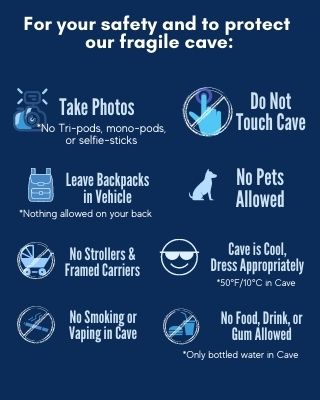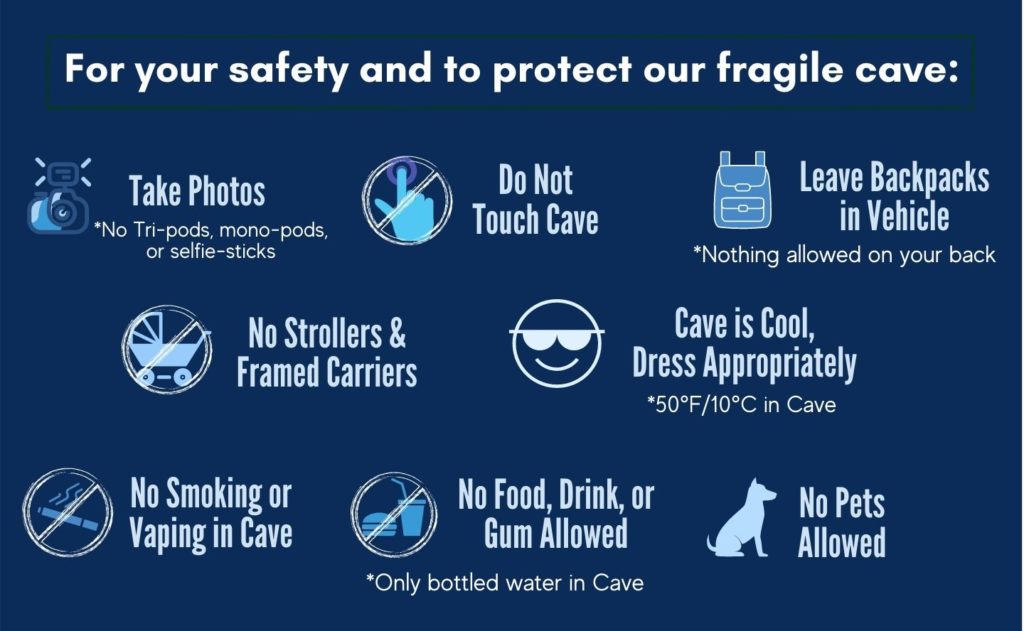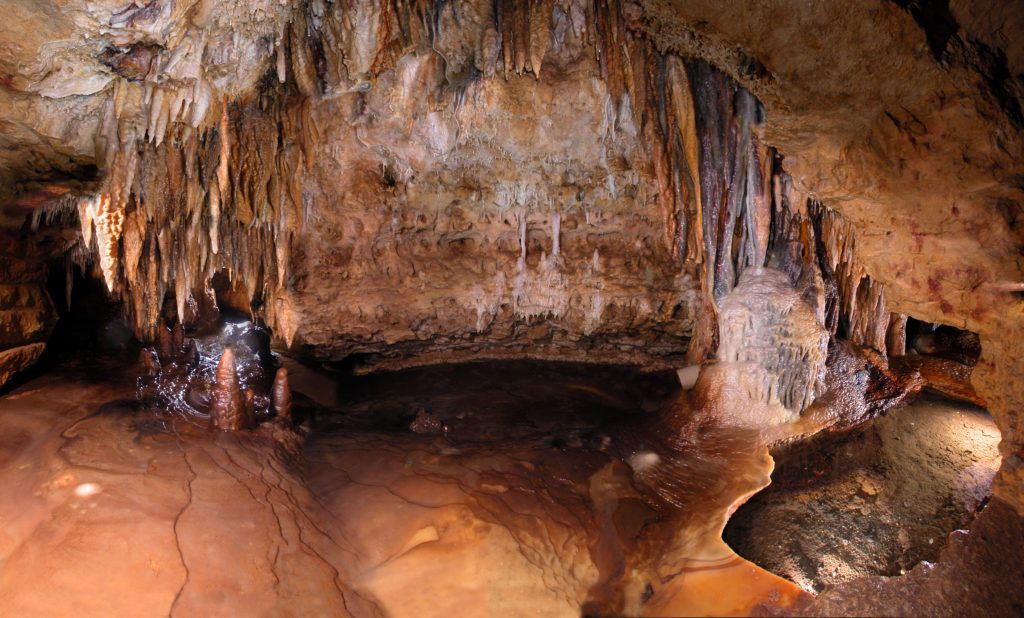Cave FAQs
Answers to Frequently Asked Questions about this Midwest Cave
Seasonal Tour Times
Summer
Memorial Day through Labor Day
EVERY DAY
Traditional Guided Tours at 9:15 AM, 9:30 AM, and 4 PM
Self-Paced Guided Tours from 10 AM until 3 PM
Last entry at 4 PM
Fall
After Labor Day through October 31st
All Traditional Guided Tours, except Saturdays from 10 AM until 3 PM
Weekdays: Every 30 minutes starting at 9:30 AM
Weekends: Every 15 minutes starting at 9:30 AM
Last entry at 4 PM
Winter
November 1st through March 15th
All Traditional Guided Tours
Weekdays: 9:30, 10, 11, 12, 1, 2, 3, 4
Weekends: Every 30 minutes starting at 9:30 AM
Last entry at 4 PM
Spring
March 15th until before Memorial Day
All Traditional Guided Tours
Weekdays: Every 30 minutes starting at 9:30 AM
Weekdays: Every 15 minutes starting at 9:30 AM
Last entry at 4 PM
*Tour Times are subject to change*
What is a Museum-Style Tour?
What is a Self-Paced Tour?
Take a museum-style stroll through this geologic wonder. Your walk will guide you past a stunning array of colorful crystal formations on paved lighted walkways.
As you explore, NEW signage will explain the science and history, and our staff are stationed throughout the cave to make sure that you enjoy your experience.
Visitors enjoy the Cave’s constant 50-degree temperature which makes the cave feel cool in the summer and warm in the winter. These museum-style tours are typically run from Memorial Day through Labor Day Weekend.
What is a Traditional Tour?
What is a Self-Paced Tour?
A guide will lead a small group through this geologic wonder. Your guide will explain the beautiful stunning array of colorful crystal formations while walking on paved lighted walkways.
These tours take 45 to 55 minutes. The guide will show you all the amazing features of our unique destination.
Whether you’re a curious tourist or a budding cave enthusiast, Cave of the Mounds has something for everyone to discover at one of the caverns in Wisconsin.
THE CAVE
The total surveyed length of this Midwest Cave (lengths of the caverns, Meanders, and every nook and cranny added together) is 1692 feet. The straight-shot length of the caverns, from the “South End Collapse” to the end of the “Dream River Room” (as the bat flies, though Cave of the Mounds doesn’t have bats!) is approximately 750 feet. We walk about 1/5 of a mile (about 1100 feet) on the tour.
Distances from floor of Cave to surface:
- South End Collapse 42 feet
- Onyx Ridge 48 feet
- North Cave 57 feet
- North End Collapse 43 feet
- Bypass Tunnel 40 feet
Limestone is a porous rock, so air and water pass through it fairly easily. As the barometric pressure changes outside, air passes through the limestone to compensate for the change, thus either drawing air into the Midwest Cave or pushing it out.
Bats, coyotes, raccoons, and other trogloxenes that might have used the Cave for shelter would have needed a natural opening to enter and exit through. Before Cave of the Mounds was discovered in 1939, it was a closed system. That means, there were no natural openings from the Midwest Cave to the surface above, keeping it hidden for millions of years. Most caves are discovered via a natural opening created by a sinkhole or other natural occurrence, so this unique feature distinguishes Cave of the Mounds from other show caves in Wisconsin.
It takes approximately 100 years for cave onyx to grow 1 centimeter if perfect conditions were to exist. In reality cave formations can take even longer to form.
Your hair grows faster in 6 hours than our cave Speleothems or formations do all year
Between Memorial Day and Labor Day Weekend:
Grounds are open daily from 9 am to 5 pm
Weekdays – Tours leave frequently starting at 9:30 am
Weekends – Tours leave frequently starting at 9:30 am
Last Cave entry time is 4 pm daily
THE CAVE
Yes, and it has been since the day it was discovered. The Cave is on Brigham Farm, which was founded in 1828 by Ebenezer Brigham, the first european settler in Dane County. When he passed on, he left the property to his great nephew Charles Brigham, Sr. Charles and his family operated the property primarily as a dairy farm, but occasionally leased quarry rights to local contractors, and thus in 1939 the Cave was discovered! In 1988, Cave of the Mounds earned the National Natural Landmark designation, entering into a public-private partnership with the National Park Service. This partnership ensures that the Cave will be managed & protected for future generations as a prime example of Wisconsin’s Natural Heritage.
Cave of the Mounds was accidentally discovered on August 4, 1939. Workers, who were removing high-quality limestone from a quarry on the Brigham Farm, blasted into the Cave. The blast tore the face off the quarry and revealed a great underground cavern. All quarrying stopped and never resumed. The dynamite blast revealed a limestone cave more than twenty feet high opening into other rooms and galleries, all containing numerous mineral formations.
The excitement of the discovery brought so many curiosity seekers that the Cave had to be closed in order to preserve it. Soon, lights and wooden walkways were installed. And, in May 1940, Cave of the Mounds was opened to visitors. Millions of visitors later, the Cave’s wooden walkways were replaced with concrete; a large stone building replaced the original entry building; and theatrical lighting has been installed to dramatize the colors and shapes within the Cave. Picnic areas, walking trails, rock gardens, gift shops, and a visitor center have all since been developed.
THE CAVE
The mineral calcite is white. Reddish brown colors come from rust deposited by Leptothrixbacteria. Shades of black, purple, and gray come from manganese compounds deposited by Gallionella bacteria.
The water table is roughly 400 feet below the surface. The water table is very slowly lowering as area rivers erode the surface. The local water table is controlled primarily by the Wisconsin River.
Three methods for finding caves are seismic soundings, resistivity testing, and gravity measurements. However, due to the sensitivity of the equipment, such testing can be extremely expensive. Also, it is very difficult to determine the size of underground cavities using surface testing. Gravity testing has been done around Cave of the Mounds; and more recently seismic soundings were tried above the Song of Norway grounds.










